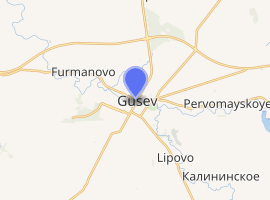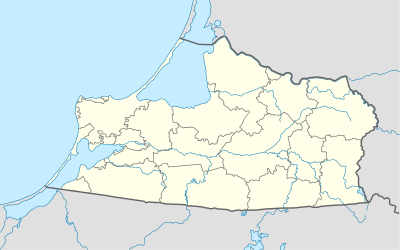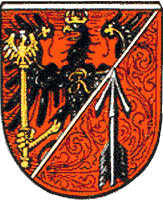Gusev, Kaliningrad Oblast
Gusev (Russian: Гу́сев), previously known by its German name Gumbinnen[5] (Lithuanian: Gumbinė; Polish: Gąbin), is a town and the administrative center of Gusevsky District of Kaliningrad Oblast, Russia, located at the confluence of the Pissa and Krasnaya Rivers, near the border with Poland and Lithuania, east of Chernyakhovsk. Population figures: 28,260 (2010 Census);[2] 28,467 (2002 Census);[6] 27,031 (1989 Census).[7]
Gusev Гусев | |
|---|---|
Town[1] | |
.png) Flag .png) Coat of arms | |
Location of Gusev 
| |
 Gusev Location of Gusev  Gusev Gusev (Kaliningrad Oblast) | |
| Coordinates: 54°35′N 22°12′E | |
| Country | Russia |
| Federal subject | Kaliningrad Oblast[1] |
| Administrative district | Gusevsky District[1] |
| Town of district significance | Gusev[1] |
| First mentioned | 1580 |
| Town status since | 1724 |
| Elevation | 45 m (148 ft) |
| Population | |
| • Total | 28,260 |
| • Capital of | Gusevsky District[1], town of district significance of Gusev[1] |
| • Urban okrug | Gusevsky Urban Okrug[3] |
| • Capital of | Gusevsky Urban Okrug[3] |
| Postal code(s)[4] | 238051 |
| Website | www |
History
The settlement of Gumbinnen (from Lithuanian: Gumbinė: pumpkin) in the Duchy of Prussia was first mentioned in a 1580 deed. A Protestant parish was established in Gumbinnen at the behest of the Hohenzollern thanks to Duke Albert of Prussia about 1545 and the first church was erected in 1582. Gumbinnen became part of Brandenburg-Prussia in 1618.
Between 1709 and 1711 the area was devastated by the Great Northern War plague outbreak and had to be redeveloped under the rule of the "Soldier King" Frederick William I of Prussia, who granted Gumbinnen town privileges in 1724 and from 1732 resettled the area with Salzburg Protestants, refugees from Salzburg, who had been expelled by Prince-Archbishop Count Leopold Anton von Firmian.[8] The first filial church of the Salzburg Protestants was erected between 1752 and 1752, and was rebuilt in 1840 in a Neoclassical style according to plans designed by Karl Friedrich Schinkel. The church was restored in 1995 by the Evangelical Lutheran Church in Russia, Ukraine, Kazakhstan and Central Asia.
From 1815, Gumbinnen was the capital of Regierungsbezirk Gumbinnen, an administrative district of the Province of East Prussia, and became part of the German Empire upon the unification of Germany in 1871. In 1860 the Prussian State railway line from Königsberg to Stallupönen (now Nesterov) was built and the route passed through Gumbinnen, causing the town to grow in economic importance in the region. By the end of the 19th century, Gumbinnen had a foundry, a machine shop, a furniture factory, a clothing mill, two sawmills, several brickworks, and a dairy.

During World War I the town was the site of the Battle of Gumbinnen, a major battle on the Eastern Front. The battle took place nearby in the opening days of the war in August 1914, and Gumbinnen was subsequently occupied by the Russian Imperial Army for several months. After the war, a power plant, the Ostpreußenwerk, was built in Gumbinnen and powered much of East Prussia. At the beginning of the Nazi era, Gumbinnen was designated a military sub-region of the Königsberg military area. Near the end of World War II, in 1944, the first of Gumbinnen's 24,000 residents began to flee from the advancing Red Army, and a Soviet air attack on October 16, 1944, caused heavy damage to the inner town area. On October 22, 1944, the town was taken by Soviet forces, who engaged in numerous vengeful atrocities against the civilian population before the Wehrmacht retook the town two days later. Although the German forces retook Gumbinnen and managed in late October to stabilize the battle line east of the town, it was quickly re-conquered by the Red Army during the great Soviet East Prussia offensive on 21 January 1945. During the Evacuation of East Prussia, the surviving German residents fled or were forcibly expelled.
Following the end of the war, under border changes promulgated at the Potsdam Conference in 1945, the northern part of East Prussia became a part of the Soviet Union, including Gumbinnen. The town was renamed Gusev, in honour of a Red Army captain, Sergei Ivanovich Gusev, who was killed in action near Gumbinnen in January 1945, and was posthumously given the award of Hero of the Soviet Union on April 19, 1945.
Administrative and municipal status
Within the framework of administrative divisions, Gusev serves as the administrative center of Gusevsky District.[1] As an administrative division, it is incorporated within Gusevsky District as the town of district significance of Gusev.[9]
Within the framework of municipal divisions, since June 10, 2013, the territories of the town of district significance of Gusev and of four rural okrugs of Gusevsky District are incorporated as Gusevsky Urban Okrug.[3] Before that, the town of district significance was incorporated within Gusevsky Municipal District as Gusevskoye Urban Settlement.[3]
Economy
Transportation
Gusev lies on the double-track, broad-gauge rail line connecting the Kaliningrad Oblast exclave through Lithuania and Belarus with the main contiguous territory of Russia.
The Yantar Special Economic Zone
In the 1990s the Yantar Special Economic Zone was established in Kaliningrad Oblast. Some of projects in the zone are located in Gusev, such as NPO CTS.
Notable people
- Kristijonas Donelaitis (1714–1780) a Prussian Lithuanian Lutheran pastor and poet
- Christian Daniel Rauch (1777–1857), German sculptor
- Otto von Corvin (1812–1886), German writer
- Gustav Albert Peter (1853–1937) a German botanist.
- Richard Friese (1854–1918) German animal and landscape painter
- Konrad Grallert von Cebrów (1865–1942), divisional commander in the Austro-Hungarian Army
- Gotthard Heinrici (1886–1971), German general
- Bruno Bieler (1888–1966), German general
- Max Liedtke (1894-1955), German army officer, one of the Righteous Among the Nations
- Werner Dankwort (1895–1986), German diplomat
- Winfried Mahraun (1907–1973) German diver who competed in the 1936 Summer Olympics
- Wilhelm Schöning (1908–1987) Oberstleutnant, commander of the 66th Panzergrenadier Regiment
- Karin Krebs (born 1943), German athlete
- Oleg Gazmanov (born 1951), Russian pop-singer, composer and poet
- Nikolay Tsukanov (born 1965) a Russian politician, psychologist, businessman, electrical welder and former governor of Kaliningrad Oblast
- Vladimir Vdovichenkov (born 1971), Russian actor
Twin towns and sister cities
Gusev is twinned with:



References
Notes
- Law #463
- Russian Federal State Statistics Service (2011). "Всероссийская перепись населения 2010 года. Том 1" [2010 All-Russian Population Census, vol. 1]. Всероссийская перепись населения 2010 года [2010 All-Russia Population Census] (in Russian). Federal State Statistics Service.
- Law #230
- Почта России. Информационно-вычислительный центр ОАСУ РПО. (Russian Post). Поиск объектов почтовой связи (Postal Objects Search) (in Russian)
- M. Kaemmerer (2004). Ortsnamenverzeichnis der Ortschaften jenseits von Oder u. Neiße (in German). ISBN 3-7921-0368-0.
- Russian Federal State Statistics Service (May 21, 2004). "Численность населения России, субъектов Российской Федерации в составе федеральных округов, районов, городских поселений, сельских населённых пунктов – районных центров и сельских населённых пунктов с населением 3 тысячи и более человек" [Population of Russia, Its Federal Districts, Federal Subjects, Districts, Urban Localities, Rural Localities—Administrative Centers, and Rural Localities with Population of Over 3,000] (XLS). Всероссийская перепись населения 2002 года [All-Russia Population Census of 2002] (in Russian).
- "Всесоюзная перепись населения 1989 г. Численность наличного населения союзных и автономных республик, автономных областей и округов, краёв, областей, районов, городских поселений и сёл-райцентров" [All Union Population Census of 1989: Present Population of Union and Autonomous Republics, Autonomous Oblasts and Okrugs, Krais, Oblasts, Districts, Urban Settlements, and Villages Serving as District Administrative Centers]. Всесоюзная перепись населения 1989 года [All-Union Population Census of 1989] (in Russian). Институт демографии Национального исследовательского университета: Высшая школа экономики [Institute of Demography at the National Research University: Higher School of Economics]. 1989 – via Demoscope Weekly.
- Turner, George. Salzburger, Ostpreußen - Integration und Identitätswahrung (in German).
- Resolution #640
- "Tarptautinis Bendradarbiavimas". Retrieved May 4, 2014.
Sources
- Калининградская областная Дума. Закон №463 от 27 мая 2010 г. «Об административно-территориальном устройстве Калининградской области», в ред. Закона №450 от 3 июля 2015 г. «О внесении изменений в Закон Калининградской области "Об административно-территориальном устройстве Калининградской области"». Вступил в силу со дня официального опубликования. Опубликован: "Калининградская правда" (вкладыш "Ведомости Правительства Калининградской области"), №112, 26 июня 2010 г. (Kaliningrad Oblast Duma. Law #463 of May 27, 2010 On the Administrative-Territorial Structure of Kaliningrad Oblast, as amended by the Law #450 of July 3, 2015 On Amending the Law of Kaliningrad Oblast "On the Administrative-Territorial Structure of Kaliningrad Oblast". Effective as of the day of the official publication.).
- Правительство Калининградской области. Постановление №640 от 30 августа 2011 г. «Об утверждении реестра объектов административно-территориального деления Калининградской области», в ред. Постановления №877 от 21 ноября 2011 г «О внесении изменения в Постановление Правительства Калининградской области от 30 августа 2011 г. №640». Вступил в силу со дня официального опубликования. Опубликован: "Калининградская правда" (вкладыш "Официально"), №170, 15 сентября 2011 г. (Government of Kaliningrad Oblast. Resolution #640 of August 30, 2011 On the Adoption of the Registry of the Objects of the Administrative-Territorial Divisions of Kaliningrad Oblast, as amended by the Resolution #877 of November 21, 2011 On Amending the Resolution of the Government of Kaliningrad Oblast #640 of August 30, 2011. Effective as of the day of the official publication.).
- Калининградская областная Дума. Закон №230 от 29 мая 2013 г. «О преобразовании Гусевского городского поселения, Калининского, Кубановского, Маяковского и Михайловского сельских поселений путём объединения поселений и наделении вновь образованного городского поселения статусом городского округа». Вступил в силу по истечении 10 дней со дня официального опубликования, за исключением статей 4, 5. Опубликован: "Калининградская правда", №92, 31 мая 2013 г.. (Kaliningrad Oblast Duma. Law #230 of May 29, 2013 On the Transformation of Gusevskoye Urban Settlement, Kalininskoye, Kubanovskoye, Mayakovskoye, and Mikhaylovskoye Rural Settlements by Merging the Settlements and Granting the Newly Formed Urban Settlement Urban Okrug Status. Effective as of the day which is 10 days after the day of the official publication, with the exception of Articles 4, 5.).
External links
- Unofficial website of Gusev (in Russian)
- Winter trip to Gusev town (in English)